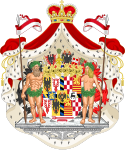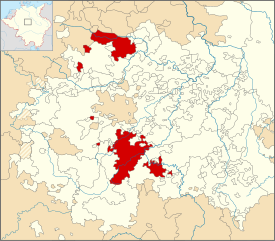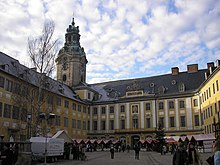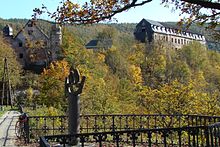Schwarzburg-Rudolstadt
|
||||||||||||||||||||||||||||||||||||||||
Schwarzburg-Rudolstadt is the name of a principality in Thuringia , which was initially formed in 1599 as the Grafschaft Schwarzburg-Rudolstadt and was a principality from 1710 to 1918. After the fall of the monarchy, the country became the Free State of Schwarzburg-Rudolstadt in 1918 and was incorporated into the State of Thuringia in 1920 .
history
The history of the principality goes back to the dynasty of the Counts of Schwarzburg , who first took their current name in 1123. Through various divisions and acquisitions, the Grafschaft Schwarzburg frequently changed its shape up to the 16th century. After the death of Count Günther XLI. in 1583, his two brothers divided the county of Schwarzburg and from 1584 formed the two main lines Schwarzburg-Arnstadt and Schwarzburg-Rudolstadt . With the Stadtilmer Treaty of November 21, 1599, the Schwarzburg territories were redistributed. The areas of the two counties and later principalities of Schwarzburg-Rudolstadt and Schwarzburg-Sondershausen remained essentially unchanged until 1920. Schwarzburg-Rudolstadt was part of the Upper Saxon Empire .
In 1697, Emperor Leopold I declared that he was elevated to the rank of imperial prince. Albert Anton did not accept the survey. In 1710, Emperor Joseph I raised the issue again, and Schwarzburg-Rudolstadt accepted. Admission to the Imperial Council of Dukes did not take place until 1754. The feudal rights of Electoral Saxony had to be settled financially beforehand.
In 1815 the principality joined the German Confederation after having become a member of the Rhine Confederation in 1807 and was thus under the protection of Napoleon until 1813 . In 1816 the country's first constitution came into force. In 1835 the country joined the German Customs Union .
In 1848 there were also unrest in the Principality of Schwarzburg-Rudolstadt, which resulted in vigilante groups being formed and federal troops deployed in the autumn of that year . The new electoral law with a general, equal and indirect electoral system was not overridden until 1854 by a new electoral law for the Landtag with three-class voting rights , the liberal laws of 1848 and a new Basic Law for the Principality. After Schwarzburg-Rudolstadt voted in the German War in 1866 against the mobilization against Prussia requested by Austria in the Bundestag of the German Confederation , the Principality joined the new North German Confederation , whereby in 1867 military sovereignty passed to Prussia. On January 1, 1871, the federal government became the German Empire.
After repeated rejection of tax increases by the state parliament, Schwarzburg-Rudolstadt was in a state crisis in 1870 and had to report its bankruptcy to the Federal Presidium . The bourgeoisie was only prepared to take on additional financial burdens if they had greater political and economic freedom. The ministry was unable to save costs by restricting the ministerial bureaucracy and the court , so that at the end of 1870 the state parliament achieved an electoral reform. Thereafter, the state parliament was composed of four members of the highest taxable population and twelve members who emerged from general equal elections for male nationals in twelve electoral districts. At the beginning of the 20th century, the progressive state election law resulted in a large number of state parliament members from the SPD , which in 1911 had an absolute majority in the state parliament for the first time and, in Franz Winter, was the first social democratic state parliament president in Germany. The French war indemnities, higher tax revenues due to an economic boom and a new income tax law of 1876 ended the crisis in the state finances, but did nothing to change the highest national debt in Thuringia at 48 marks per inhabitant in 1910.
After the end of World War I thanked - about two weeks later than the other federal princes - on November 23, 1918 Prince Günther Victor , who in personal union since 1909 that the Principality of Schwarzburg-Sondershausen reigned as the last German monarch from. Without prior amendment to the constitution, he said, the monarchy cannot be abolished - an argument that the SPD majority in the state parliament would not want to ignore. At the end of November 1918, the Free State of Schwarzburg-Rudolstadt was established , which in 1920 became part of the new state of Thuringia .
The childless Prince Günther Victor died in Sondershausen in 1925 and his wife Anna Luise in 1951 . He was succeeded as head of the Schwarzburg family by Prince Sizzo von Leutenberg , who was declared entitled to inheritance in 1896 and came from a morganatic marriage of Prince Friedrich Günther von Schwarzburg-Rudolstadt, who died in 1867, with Countess Helene von Reina. His son Friedrich Günther died on November 9, 1971 in Munich and was the last family member entitled to succeed to the throne . There is still a name holder. Friedrich Günther and Sophie Luise, née Princess of Saxe-Weimar-Eisenach, married in 1938 and immediately divorced, and remained childless. The descendants of his sister Marie Antoinette bear the name Graf or Countess zu Solms-Wildenfels.
Further data
Places with more than 2000 inhabitants in 1910:
| place | Residents Dec. 1, 1910 |
|---|---|
| Rudolstadt | 12,937 |
| Bad Frankenhausen | 6,566 |
| Stadtilm | 3,798 |
| Bad Blankenburg | 3,450 |
| Koenigsee | 3,209 |
| Schlotheim | 3,104 |
| Neuhaus am Rennweg | 2,553 |
| Oberweißbach | 2.117 |
| Meuselbach | 2,049 |
Total population:
- 1871: 75,523 inhabitants
- 1900: 93,059 inhabitants
- 1910: 100,702 inhabitants
About 98.5% allegiance to the Evangelical - Lutheran Church .
The national territory of Schwarzburg-Rudolstadt consisted of the three separate areas of Rudolstadt , Frankenhausen and Leutenberg . There were also a large number of exclaves .
Supremacy
- Area: 735 km²
- Cities: Rudolstadt , Bad Blankenburg , Königsee , Oberweißbach , Schwarzburg , Stadtilm
- District offices: Rudolstadt and Königsee
- Exclaves: Angelroda , Elxleben , Leutenberg , Oesteröda , Seebergen , Weisbach bei Leutenberg
Subordination
- Area: 206 km²
- Cities: Frankenhausen , Straussberg
- District Office: Frankenhausen
- Exclaves: Schlotheim , Straussberg , Immenrode
The offices of Kelbra and Heringen in Northern Thuringia were jointly owned between 1419 and 1815 by the Counts of Schwarzburg (from 1599 Schwarzburg-Rudolstadt) and Counts of Stolberg (from 1706 Stolberg-Roßla ) under the suzerainty of the Albertine Wettins (later Electorate of Saxony ).
Currency and mail shelf
The Principality joined the Dresden Mint Treaty in 1838 . Two dollars in the Prussian 14-taler monetary standard now corresponded to 3 1 / 2 South German Gulden in 24 1 / 2 -Gulden-feet, which should be considered as common club coin of the "contra end here states". This club coin of "2 Taler = 3 1 ⁄ 2 Gulden" was legally valid in every Zollverein country - regardless of who the respective issuer of the club coin was. Schwarzburg-Rudolstadt minted its own coins:
- for the supremacy of Rudolstadt in the Bavarian Münzfuß (1 guilder at 60 Kreuzer at 240 pfennigs), mint in Munich 1841–1861,
- for the subordinate rule Frankenhausen in the Prussian mint (1 speciestaler at 32 groschen at 384 pfennigs, then 1 Reichstaler at 24 groschen at 288 pfennigs, from 1838 1 taler at 30 silver groschen at 360 pfennigs), mints existed in Saalfeld until 1841, Berlin 1841–1889 .
It was only with the introduction of the mark as imperial currency on January 1, 1876 under the law of December 4, 1871, that the fragmentation of the monetary system was lifted.

The Thurn-und-Taxis-Post secured the post office shelf through contracts with the Schwarzburg principalities:
- June 8, 1812 with Schwarzburg-Sondershausen for the suzerainty of Arnstadt,
- August 23, 1817 with Schwarzburg-Rudolstadt for the supremacy of Rudolstadt.
The sublords of Sondershausen and Frankenhausen were administered by the Prussian post office.
The common administration could already be recognized from the outside by the name, the postal coat of arms and the uniforms, which differed by different collar colors. The name of the post office was: “Fürstlich Schwarzburg-Rudolst., Fürstlich Thurn und Taxissche Lehenspostexpedition”. The postal coat of arms therefore combined both coats of arms, below the Schwarzburger, above the princely Thurn and Taxissche (see illustration). From 1852 to 1866, the Thurn-und-Taxis-Post issued its own postage stamps in two different currencies. The supremacy belonged to the southern district with cruciform currency. From 1867 the post office shelf passed to Prussia, which - like the North German Confederation - issued stamps in Groschen and Kreuzer currency until the introduction of the Reich currency in 1876.
Judiciary
The higher regional court in Jena, which is common to all Thuringian states, had jurisdiction . It comprised the four Saxon-Ernestine states, the Principality of Schwarzburg-Rudolstadt and the two Russian principalities as well as the Prussian districts of Schmalkalden, Schleusingen and Ziegenrück. The second instance represented the district court of Rudolstadt, to which seven district courts were subordinate in the principality. The district court also acted for the Saalfeld district of Sachsen-Meiningen and the Prussian district of Ziegenrück.
- District Court of Rudolstadt (for Schwarzburg-Rudolstadt, the Saalfeld district of Saxony-Meiningen and the Prussian district of Ziegenrück in the province of Saxony) with the fourteen district courts of Leutenberg , Königsee , Oberweißbach , Rudolstadt , Stadtilm (for the supremacy of Rudolstadt ); Frankenhausen , Schlotheim (for the sub-rule Frankenhausen ); Camburg , Graefenthal , Kranichfeld , Pößneck , Saalfeld (for the Saalfeld district); Ranis , Ziegenrück (for the district of Ziegenrück).
military
As a member of the German Confederation , the principality provided a contingent of 539 infantry and belonged to the 10th battalion of the reserve division of the armed forces . The contingents of both principalities together formed a battalion. In Rudolstadt and in Sondershausen there were two companies each, of which only one sixth were regularly present. It was not until 1850 that the number of troops was doubled, so that each royal house now provided a battalion.
After the military convention concluded with Prussia on February 4, 1867 in the German Empire, the princely military, together with the contingents of Sachsen-Altenburg and the two Reuss, formed the 7th Thuringian Infantry Regiment No. 96, which belonged to the 4th Prussian Army Corps in Magdeburg and from which was garrisoned by a battalion in Rudolstadt .
coat of arms
The coat of arms of Schwarzburg-Rudolstadt is the same as that of Schwarzburg-Sondershausen, only the field of regalia differed in the two principalities. Blazon of the large national coat of arms: the shield holder of the coat of arms is on the left (heraldic right) a wild man , on the right (heraldic left) a female counterpart. The main shield is split and is covered by a narrow, blue-gold-black diagonally arranged cross that extends to the base of the shield (The cross comes from the title of "Viergrafen des Reiches", which the Counts of Schwarzburg led since 1356 and that of the German emperors in 1518, 1566, 1576, 1612 and 1638 was renewed or confirmed.).
- Left half, fields 1 and 4: In gold, a black, gold-armed and red-tongued eagle (Herrschaft Arnstadt ).
- Left half, fields 2 and 3: In silver, a red deer antler with three lateral and three upper ends (Herrschaft Sondershausen ).
- Right half, fields 1 and 4: red-silver box ( Grafschaft Hohnstein ).
- Right half, fields 2 and 3: In red over four golden bars a golden, double-tailed lion with a red tongue and reinforcement ( Grafschaft Lauterberg ).
- Schildfuß: Shelf sign in silver because of the mountain shelf and the own silver mining in the people mountain range.
- Heart shield of the left half of the shield: In blue a golden, looking lion, crowned in gold and tongued with red and double-tailed. (County of Schwarzburg ).
- Heart shield of the right half of the shield: In silver a black striding deer ( Klettenberg ).
- Middle heart shield: The German imperial eagle in gold (also a small national coat of arms. In memory of the German royal dignity which Günther XIX held in 1349).
Ruling counts and princes
With the division of the Schwarzburg lands in 1599, the main line between Schwarzburg and Rudolstadt was formed.
- 1574–1605 Count Albrecht VII (1537–1605), son of Günther XL.
- 1605–1630 Count Karl Günther (1576–1630)
- and also 1612–1634 Count Albrecht Günther (1582–1634)
- and also 1612–1646 Count Ludwig Günther I (1581–1646)
- 1646–1662 guardian; Emilie von Delmenhorst (1614–1670)
- 1662–1710 Count Albert Anton (1641–1710)
- 1710–1718 Prince Ludwig Friedrich I (1667–1718)
- 1718–1744 Prince Friedrich Anton (1692–1744)
- 1744–1767 Prince Johann Friedrich (1721–1767)
- 1767–1790 Prince Ludwig Günther II. (1708–1790)
- 1790–1793 Prince Friedrich Karl (1736–1793)
- 1793–1807 Prince Ludwig Friedrich II. (1767–1807)
- 1807–1814 guardian; Caroline of Hessen-Homburg (1771-1854)
- 1814–1867 Prince Friedrich Günther (1793–1867)
- 1867–1869 Prince Albert (1798–1869)
- 1869–1890 Prince Georg Albert (1838–1890)
- 1890–1918 Prince Günther Victor (1852–1925)
minister
- Hermann Jakob von Bertrab , Minister of State from 1851 to 1887
- Franz von der Recke , Minister of State from 1909 to 1918
See also
- Family list of the Schwarzburg family
- Principality of Schwarzburg-Sondershausen
- Aemilie Juliane von Schwarzburg-Rudolstadt , b. Countess of Barby and Mühlingen; (1637–1706), poet of sacred songs
- Marie von Schwarzburg-Rudolstadt (1850–1922), Princess of Schwarzburg-Rudolstadt; Grand Duchess of Mecklenburg [-Schwerin]
literature
- Friedrich Apfelstedt : The House of Kevernburg-Schwarzburg from its origins to our time . Thüringer Chronik-Verlag HE Müllerott, Arnstadt 1996, ISBN 3-910132-29-4 (1890, new edition).
- Johann Christian August Junghans: History of the Black Castle Regents. Hartmann, Leipzig 1821, [1] .
- Ermentrude von Ranke: The Principality of Schwarzburg-Rudolstadt at the beginning of the 18th century. The land dispute against the princely arbitrariness before the Reich Chamber Court and Reichshofrat. Kaemmerer, Hall a. S. 1915 (Halle-Wittenberg, Univ., Diss., 1915).
- Jens Henkel, Lutz Unbehaun (Red.): The princes of Schwarzburg-Rudolstadt. 1710-1918. Thuringian State Museum Heidecksburg, Rudolstadt 1997, ISBN 3-910013-27-9 (3rd edition. (= Small series of cultural history. Volume 1). Ibid 2001).
- Jens Beger et al. (Red.): The Counts of Schwarzburg-Rudolstadt. Albrecht VII. To Albert Anton (= small series of cultural history. Volume 3). Thuringian State Museum Heidecksburg, Rudolstadt 2000, ISBN 3-910013-40-6 .
- Hans Herz: Land and committee days in Schwarzburg-Rudolstadt 1531-1736. Jena, Stuttgart, Lübeck, Ulm 1997, ISBN 3-437-35378-0 .
- Ulrich Hess: History of the state authorities in Schwarzburg-Rudolstadt. Jena, Stuttgart 1994, ISBN 3-334-60503-5 .
- Heinrich Schöppl: The regents of the principality Schwarzburg-Rudolstadt. Rudolstadt 1915.
- Lutz Unbehaun (ed.): The Schwarzburger military. An overview of troop history, armament and uniforms in the principalities of Schwarzburg-Rudolstadt and Schwarzburg-Sondershausen 1700 to 1914. Thuringian State Museum Heidecksburg, Rudolstadt 1994, ISBN 3-910013-13-9 .
- Karlheinz Blaschke , Uwe Ulrich Jäschke : Kursächsischer Ämteratlas. Leipzig 2009, ISBN 978-3-937386-14-0 , p. 90 f. (Offices Kelbra and Heringen)
Web links
- Principality of Schwarzburg-Rudolstadt 1700–1918
- Principality of Schwarzburg-Rudolstadt (district offices and municipalities) 1910
- Overview of the Counts and Princes of Schwarzburg since 1571
- Schwarzburg-Rudolstadt from HGIS Germany (PDF; 38 kB)
- Schwarzburg-Rudolstadt . In: Meyers Konversations-Lexikon . 4th edition. Volume 14, Verlag des Bibliographisches Institut, Leipzig / Vienna 1885–1892, p. 690.
- Schwarzburgische Landesgeschichte Thuringia overarching regional historical presentations with a focus on the history of the entire Schwarzburg territory
- House Laws of Schwarzburg
- Map of Schwarzburg-Rudolstadt
- Heidecksburg residential palace with information on the Schwarzburg-Rudolstädter line
- Schwarzburg Castle with information about the noble family and the ancestral castle of the Schwarzburgers
Individual evidence
- ^ Family tree of the aristocratic family Schwarzburg
- ^ Friedrich Günther Prince of Schwarzburg
- ^ Marie Antoinette Princess of Schwarzburg
- Jump up ↑ Heinrich Ambros Eckert and Dietrich Monten, Das deutsche Bundesheer, Volume II., Dortmund 1981, p. 16.
- ↑ Meyers Konversationslexikon. Fourth edition, Volume XIV, p. 691, Leipzig 1889.
- ^ Arnold, Paul, Schwarzburg-Rudolstadt and Schwarzburg-Sondershausen, Principality, in: Large German coin catalog from 1800 to today, Munich (4th) 1974, 338.
- ↑ Meyers Konversationslexikon. Fourth edition, Volume XIV, p. 691, Leipzig 1889.








